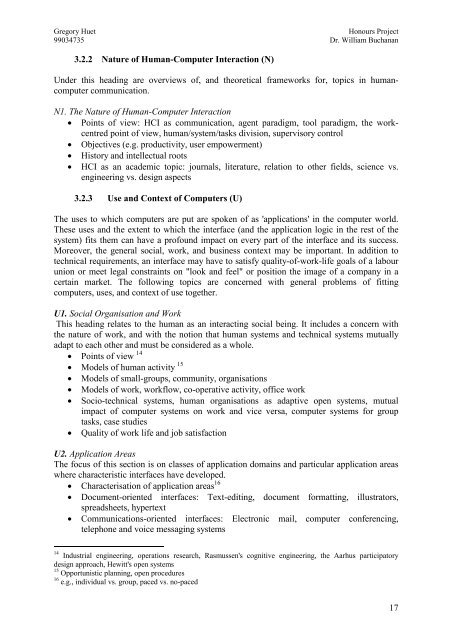Honours Project: - Napier University
Honours Project: - Napier University
Honours Project: - Napier University
Create successful ePaper yourself
Turn your PDF publications into a flip-book with our unique Google optimized e-Paper software.
Gregory Huet<br />
<strong>Honours</strong> <strong>Project</strong><br />
99034735 Dr. William Buchanan<br />
3.2.2 Nature of Human-Computer Interaction (N)<br />
Under this heading are overviews of, and theoretical frameworks for, topics in humancomputer<br />
communication.<br />
N1. The Nature of Human-Computer Interaction<br />
• Points of view: HCI as communication, agent paradigm, tool paradigm, the workcentred<br />
point of view, human/system/tasks division, supervisory control<br />
• Objectives (e.g. productivity, user empowerment)<br />
• History and intellectual roots<br />
• HCI as an academic topic: journals, literature, relation to other fields, science vs.<br />
engineering vs. design aspects<br />
3.2.3 Use and Context of Computers (U)<br />
The uses to which computers are put are spoken of as 'applications' in the computer world.<br />
These uses and the extent to which the interface (and the application logic in the rest of the<br />
system) fits them can have a profound impact on every part of the interface and its success.<br />
Moreover, the general social, work, and business context may be important. In addition to<br />
technical requirements, an interface may have to satisfy quality-of-work-life goals of a labour<br />
union or meet legal constraints on "look and feel" or position the image of a company in a<br />
certain market. The following topics are concerned with general problems of fitting<br />
computers, uses, and context of use together.<br />
U1. Social Organisation and Work<br />
This heading relates to the human as an interacting social being. It includes a concern with<br />
the nature of work, and with the notion that human systems and technical systems mutually<br />
adapt to each other and must be considered as a whole.<br />
• Points of view 14<br />
• Models of human activity 15<br />
• Models of small-groups, community, organisations<br />
• Models of work, workflow, co-operative activity, office work<br />
• Socio-technical systems, human organisations as adaptive open systems, mutual<br />
impact of computer systems on work and vice versa, computer systems for group<br />
tasks, case studies<br />
• Quality of work life and job satisfaction<br />
U2. Application Areas<br />
The focus of this section is on classes of application domains and particular application areas<br />
where characteristic interfaces have developed.<br />
• Characterisation of application areas 16<br />
• Document-oriented interfaces: Text-editing, document formatting, illustrators,<br />
spreadsheets, hypertext<br />
• Communications-oriented interfaces: Electronic mail, computer conferencing,<br />
telephone and voice messaging systems<br />
14 Industrial engineering, operations research, Rasmussen's cognitive engineering, the Aarhus participatory<br />
design approach, Hewitt's open systems<br />
15 Opportunistic planning, open procedures<br />
16 e.g., individual vs. group, paced vs. no-paced<br />
17










![Unit 5. Switches and VLANs [PDF]](https://img.yumpu.com/34422504/1/184x260/unit-5-switches-and-vlans-pdf.jpg?quality=85)





